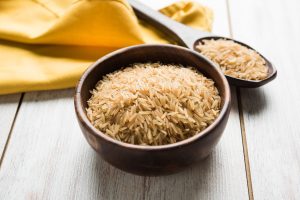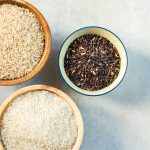What are Whole Grains?
Whole grains are an essential part of a balanced diet, offering a wealth of nutrients, fiber, and flavor that can elevate any meal. Unlike refined grains, whole grains retain all parts of the grain kernel—the bran and endosperm—ensuring that they are packed with vitamins, minerals, and other beneficial compounds. This extensive guide will delve into seven popular whole grains: buckwheat, quinoa, black rice, brown rice, wild rice, and oatmeal. We will explore their unique characteristics, provide detailed cooking tips, and offer creative ways to incorporate them into your diet.
Buckwheat
Buckwheat is a unique grain that is actually a seed, but are considered grains from both a nutritional and culinary perspective.
It has a distinctive, slightly earthy or woody flavor and a firm texture when cooked. Buckwheat is naturally gluten-free and is rich in protein, fiber, and essential minerals such as manganese and magnesium. It is also a good source of antioxidants.
Cooking Tips:
- Rinsing: Rinse buckwheat thoroughly under cold water before cooking. This helps remove any dust and reduces any bitterness.
- Ratio: Use a 2:1 water-to-buckwheat ratio for best results. For example, for one cup of buckwheat, use two cups of water.
- Cooking Time: Buckwheat generally takes 10-15 minutes to cook. Bring the water to a boil, then reduce the heat to a simmer and cover. Once the water is absorbed and the buckwheat is tender, remove from heat and let it sit for a few minutes.
- Flavoring: To enhance buckwheat’s flavor, toast it in a dry skillet over medium heat for 3-5 minutes before cooking. You can also cook it in vegetable or chicken broth to add depth of flavor.
Usage: Buckwheat is versatile and can be used in a variety of dishes. It makes an excellent base for salads, can be added to soups, or used in grain bowls. You can also incorporate it into baking recipes such as pancakes or bread for a unique twist.
Quinoa
Quinoa, often mistaken for a grain, is actually a seed from the Chenopodium plant. It is renowned for its high protein content and is considered a complete protein, meaning it provides all nine essential amino acids. Quinoa has a slightly nutty flavor and a fluffy, light texture when cooked. It is also gluten-free and rich in iron, magnesium, and fiber.
Cooking Tips:
- Rinsing: Quinoa has a natural coating called saponin that can be bitter. Rinse quinoa thoroughly under cold water before cooking to remove this coating.
- Ratio: Use a 2:1 water-to-quinoa ratio. For every cup of quinoa, use two cups of water or broth.
- Cooking Time: Simmer quinoa for 15-20 minutes. You will know it is done when the white germ ring becomes visible around each seed and the liquid has been absorbed.
- Flavoring: To bring out quinoa’s nutty flavor, toast it lightly in a dry pan before cooking. For added flavor, cook quinoa in vegetable or chicken broth instead of water, and consider adding herbs, spices, or a splash of citrus juice.
- Usage: Quinoa is highly versatile. Use it as a base for salads, mix it into soups, or serve it as a side dish. It can also be used in place of rice in many recipes, or even as a breakfast porridge. Try it with fruits, nuts, and a touch of honey for a nutritious morning meal.
Black Rice
Black rice, also known as forbidden rice, is celebrated for its striking color and rich flavor. It is high in antioxidants, particularly anthocyanins, which are the same compounds that give blueberries their color. Black rice also provides a good amount of fiber, iron, and protein. When cooked, its color turns a deep purple, making it visually stunning on the plate.
Cooking Tips:
- Rinsing: Rinse black rice thoroughly under cold water to remove excess starch.
- Ratio: Use a 2.5:1 water-to-black rice ratio. For one cup of black rice, use 2.5 cups of water.
- Cooking Time: Black rice takes longer to cook compared to other rice varieties. Simmer for 30-40 minutes, or until the rice is tender and the water is absorbed. If you find that the rice is still hard, add a little more water and continue cooking.
- Flavoring: For added flavor, consider cooking black rice in vegetable or chicken broth. You can also mix in some fresh herbs or spices during cooking to enhance its taste.
- Usage: Black rice works well in both savory and sweet dishes. It can be used as a base for grain bowls, mixed into salads, or served as a side dish. Its unique color and flavor also make it an interesting addition to desserts, such as rice pudding.
Brown Rice
Brown rice is a staple whole grain that is well-loved for its nutty flavor and chewy texture. It retains the bran and germ layers, making it more nutrient-dense than white rice. Brown rice is a good source of fiber, B vitamins, and essential minerals like magnesium and selenium.
Cooking Tips:
- Rinsing: Rinse brown rice under cold water to remove excess starch and prevent it from becoming gummy.
- Ratio: Use a 2:1 water-to-brown rice ratio. For every cup of brown rice, use two cups of water.
- Cooking Time: Brown rice requires a longer cooking time than white rice. Simmer for 40-50 minutes. After cooking, let it sit covered for 10 minutes before fluffing with a fork.
- Flavoring: To enhance the flavor of brown rice, you can toast it in a dry skillet before cooking. Adding herbs, spices, or a splash of soy sauce to the cooking water can also provide additional flavor.
- Usage: Brown rice is incredibly versatile. Use it as a side dish, in stir-fries, or as a base for grain bowls. It also makes a hearty addition to soups and salads. For a nutritious meal, try mixing brown rice with beans and vegetables.
Wild Rice
Wild rice is not a true rice but rather the seed of aquatic grass. It has a rich, nutty flavor and a chewy texture. Wild rice is high in protein, fiber, and essential minerals, making it a nutritious addition to your diet.
Cooking Tips:
- Rinsing: Rinse wild rice under cold water before cooking to clean it and remove excess starch.
- Ratio: Use a 3:1 water-to-wild rice ratio. For one cup of wild rice, use three cups of water.
- Cooking Time: Wild rice takes longer to cook compared to other grains. Simmer for 45-60 minutes, or until the grains are tender and the water is absorbed. If necessary, add more water and continue cooking until the desired texture is achieved.
- Flavoring: Wild rice can be cooked in vegetable or chicken broth for added flavor. Adding herbs, such as thyme or rosemary, can also enhance its taste.
- Usage: Wild rice is great in soups, stews, and salads. It also pairs well with roasted meats or can be used as a base for grain bowls. Its unique texture and flavor make it an excellent choice for special occasions.
Oatmeal
Oatmeal is made from oats, which come in various forms: steel-cut, rolled, and instant. Oats are high in fiber, particularly beta-glucan, which helps lower cholesterol and improve heart health. Oatmeal is versatile and can be enjoyed in numerous ways.
Cooking Tips:
- Rolled Oats: Use a 2:1 water-to-oats ratio. For every cup of rolled oats, use two cups of water. Simmer for 5-10 minutes until the oats are soft and have absorbed the liquid.
- Instant Oats: Instant oats are pre-cooked and dried, requiring only a brief soak in hot water or milk. Follow the package instructions for best results.
- Flavoring: Enhance oatmeal by adding fruits, nuts, seeds, or spices such as cinnamon and vanilla. For a creamier texture, cook oats in milk or a dairy-free alternative. You can also add a touch of honey or maple syrup for sweetness.
- Usage: Oatmeal is a classic breakfast option but can also be used in baking recipes. Incorporate oats into muffins, cookies, or granola bars for added texture and nutrition. Try savory oatmeal by adding vegetables and a poached egg for a filling meal.
Incorporating Whole Grains into Your Diet
Integrating whole grains into your diet can add variety and improve your overall nutrition. Here are some practical ideas for incorporating these grains into your meals:
- Breakfast: Start your day with a warm bowl of oatmeal or quinoa porridge. You can add fruits, nuts, and seeds for added texture and flavor.
- Lunch: Add cooked quinoa or black rice to salads for a protein boost. You can also use buckwheat or brown rice as a base for grain bowls, topped with vegetables, beans, and a flavorful dressing.
- Dinner: Serve brown rice, or wild rice as a side dish with your favorite protein. These grains also make a hearty base for stir-fries, pilafs, and casseroles.
- Snacks: Buckwheat can be used in energy bars or mixed into yogurt for a crunchy snack. Oats can be used in homemade granola or granola bars for a nutritious treat.
Conclusion
Whole grains such as buckwheat, quinoa, black rice, brown rice, wild rice, and oatmeal offer a diverse range of flavors, textures, and nutritional benefits. By experimenting with these grains and incorporating them into your daily meals, you can enjoy a healthier and more varied diet. Each grain brings its own unique set of qualities to the table, from the nutty crunch of buckwheat to the rich color and flavor of black rice.
Embrace the versatility of whole grains and explore new recipes to enhance your culinary experience. Whether you’re preparing a simple side dish, a hearty main course, or a nutritious breakfast, these grains can transform your meals while boosting your overall well-being. Make whole grains a regular part of your diet and discover the many ways they can contribute to a balanced and flavorful lifestyle.









